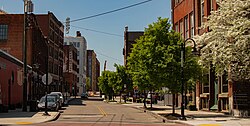Southern Terminal and Warehouse Historic District | |
 East Jackson Ave, in the Old City neighborhood | |
Location in Tennessee | |
| Location | Parts of Jackson Avenue, North and South Central Street, Gay Street, State Street, Vine Avenue and Depot Avenue Knoxville, Tennessee |
|---|---|
| Coordinates | 35°58′13″N 83°55′6″W / 35.97028°N 83.91833°W |
| Area | approximately 33 acres (13 ha)[2] |
| Built | 1870–1935[2] |
| Architect | Frank Pierce Milburn; Et al. |
| Architectural style | Chicago, Classical Revival, Romanesque Revival, Renaissance Revival, Italianate, Vernacular Commercial |
| NRHP reference No. | 85002909[1] |
| Added to NRHP | November 18, 1985 |
The Old City is a neighborhood in Knoxville, Tennessee, United States, located at the northeast corner of the city's downtown area. Originally part of a raucous and vice-ridden section of town known as "The Bowery," the Old City has since been revitalized through extensive redevelopment efforts carried out during the 1980s through the present.[3] Currently, the Old City is an offbeat urban neighborhood, home to several unique restaurants, bars, clubs, and shops.
In spite of its name, the Old City is not the oldest section of Knoxville.[3] Most of the neighborhood was not part of the city until the 1850s, when the arrival of the railroad encouraged the city to annex the areas north of Vine Avenue.[4] The railroad brought an influx of Irish immigrants, who established the Old City's first saloons and shops. After the Civil War, Knoxville developed into one of the southeast's largest wholesaling centers. Wholesalers built large warehouses, such as the ones along Jackson Avenue, where rural East Tennessee merchants came to buy the goods with which they stocked their general stores.[2]
By the early 1900s, Central Street was lined with saloons and brothels. Violent crime and prostitution continued to be a problem into the 1960s, causing many of the neighborhood's businesses to flee the area.[3] Beginning in 1986, successful redevelopment efforts led by Architect Peter Calandruccio and Builder Benny Curl revitalized the neighborhood.[3] Calandruccio's master-planning (see below) prompted other developers to begin work on other properties as the opportunity of broad-scaled development showed itself promising.
- ^ "National Register Information System". National Register of Historic Places. National Park Service. March 13, 2009.
- ^ a b c Gail Guymon, Ann Bennett, and Teresa Irwin, National Register of Historic Places Nomination Form for Southern Terminal and Warehouse Historic District, July 1985.
- ^ a b c d Melonee McKinney, "A Time of Transition an Avenue of Renaissance in Knoxville." Knoxville News Sentinel, 3 April 1994.
- ^ Jack Neely, Market Square: A History of the Most Democratic Place on Earth (Knoxville, Tenn.: Market Square District Association, 2009), pp. 7, 18, 100.


